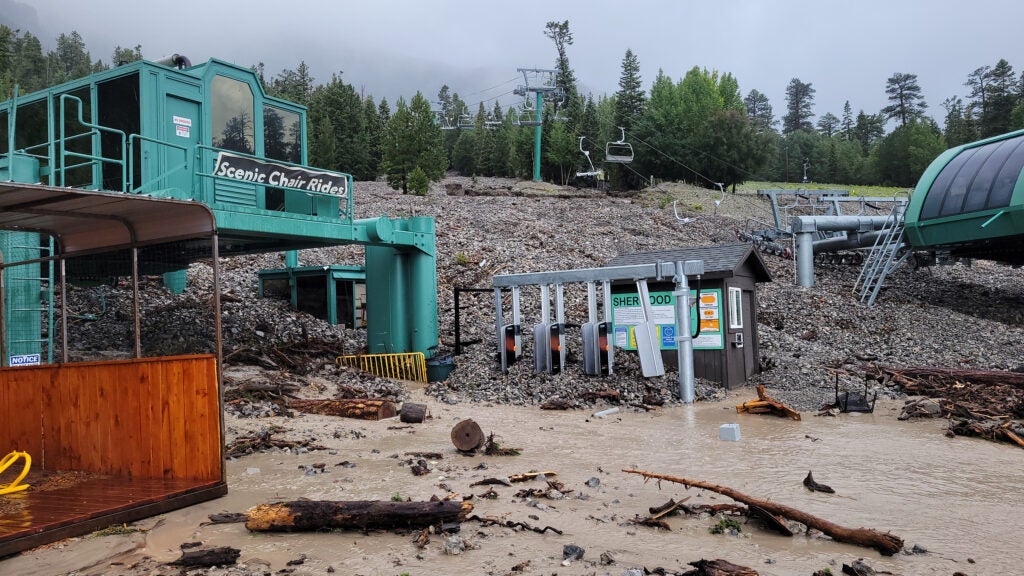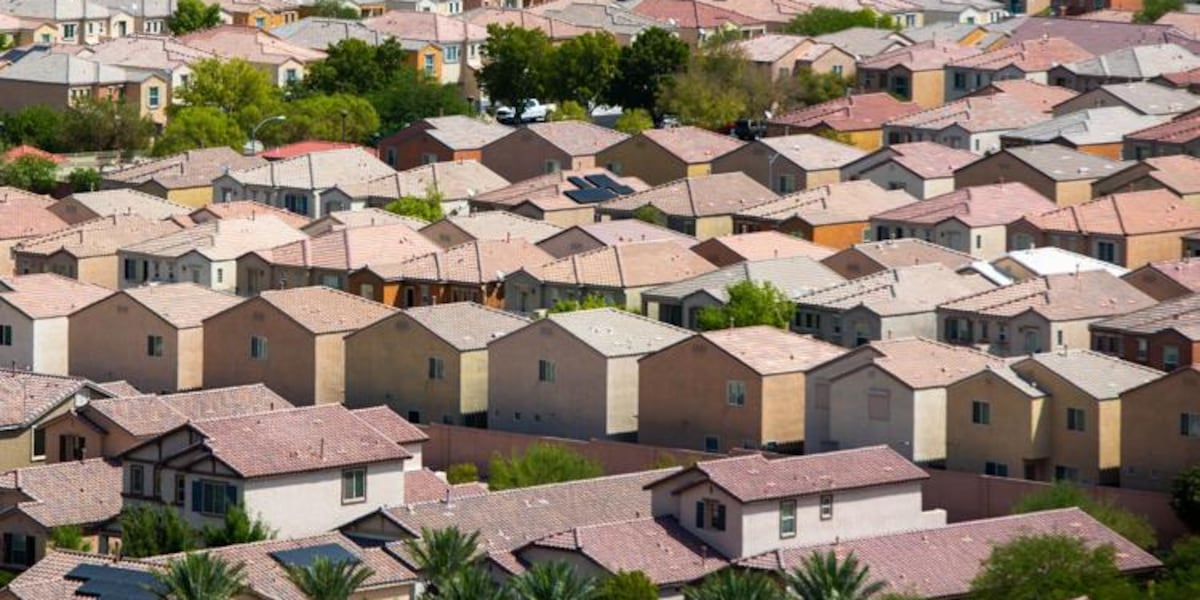Nevada
This Nevada Ski Resort Got Walloped by Tropical Storm Hilary

You’re looking at the Sherwood chairlift at the main base area of Lee Canyon, a small ski resort located about 35 miles outside Las Vegas, Nevada. What a mess, right? Stones and mud are piled high enough to reach the machine’s drive bullwheel—the apparatus that powers the lift. At the adjacent lift, Bluebird, the debris pile touches the hold-down assembly—the series of wheels and sheaves that the chair rolls over before proceeding uphill. Nobody will be riding these lifts for a while.
This past winter’s epic powder dumps in Utah and California made skiers like myself accustomed to seeing those glee-inducing photos of chairlifts disappearing into chest-high snowdrifts. The images of Lee Canyon’s lifts buried by mud and rock hit a little different, right? It’s a macabre reminder of nature’s destructive power.
The rock pile is from a massive landslide that ripped down the adjacent 11,289-foot Lee Peak over the weekend of August 19-20. The avalanche of rock and mud tore open some of Lee Canyon’s ski slopes and pushed boulders up against the towers of its lifts. Aerial images of the slide I saw on social media show exposed water pipes jutting from a rift in one run. Another image shows tree trunks scattered around the base like Lincoln Logs.
Lee Canyon and the greater Spring Mountains area was struck by remnants of Tropical Storm Hilary—the same storm that closed Death Valley National Park and other public lands, and drenched much of Southern California. The storm dropped an estimated ten inches of rain in the mountains surrounding Lee Canyon, causing flash flooding and landslides. Parts of the Mount Charleston area went days without electricity. Some of the roads and recreation areas are closed through October 1 due to the cleanup.
You can see the underground pipes of some kind have been exposed as well pic.twitter.com/P9R45NFEk8
— Mt Charleston Mountain Man (@mountainman_mc) August 24, 2023
How long will it take to remove the rocks and mud from below Lee Canyon’s chairlifts? The resort has yet to announce a timeline for the cleanup, but the U.S. Forest Service has closed the entire Spring Mountains National Recreation Area—which includes Lee Canyon Resort—indefinitely. A few days after the storm hit, the resort posted a short message on Instagram saying that it had officially ended its summer mountain biking season early. Then, on Thursday, August 24, the resort released images showing the catastrophic damage. In a statement, resort management said it still planned to be open for the 2023-24 ski season. But for the near future, all terrain, lifts, and infrastructure will remain closed.
“This was an extraordinary storm event, which has left significant damage to Lee Canyon and the Spring Mountains,” said Dan Hooper, Lee Canyon’s general manager in a statement. “Our goal is to ensure public safety. When the U.S. Forest Service deems it safe, Lee Canyon’s teams will begin restoring affected areas.”
We wish them luck, and hopd to one day see photos of the Sherwood and Bluebird lifts covered in snow.

Nevada
Upcoming legislative session bill would limit corporations buying single family homes in Nevada

LAS VEGAS, Nev. (FOX5) – For many families, the American Dream of home ownership now seems out of reach. There’s a push to change that and bring housing costs down in Nevada by limiting corporate buyers from pricing out families and individual buyers.
“You wouldn’t even know it, but this street, this whole entire street, is owned by a corporate investor. They built the houses and then they rent them out,” explained State Senator Dina Neil, who represents District Four including the North Las Vegas neighborhood where she met FOX5 for an interview.
“In this environment, the corporate owner is the only one reaping the benefit of the asset, not the family itself. Our Nevada citizens are actually being locked out,” Neal contended. Neal wants single family homes to be affordable for Nevada families.
“Fifteen percent of the market is owned by corporate investors and so this is going to change the narrative,” Neal argued. Her bill for the upcoming legislative session next month would require an investor to register with the Secretary of State, file as their deed as an investor, and limit them to buying 100 single family homes in Nevada per year.
“The reason why I’m able to legally do this is because the legislature has police powers when we’re in a crisis…We’ve been in a housing crisis for over four or five years,” Neal reported.
A CCSD teacher of ten years who wants to remain anonymous recently reached out to FOX5 about being unable to afford a home in the Las Vegas area.
“I think the average teacher that has either just started teaching or has around ten years of experience are right around the $60,000 salary mark and there’s just no homes in our budget,” the teacher stated. About half her income goes to rent. Still, she is cutting costs wherever she can to save up to hopefully one day afford a down payment.
“As a professional, you go to school and you get this degree to really help your community and we’re in this position where we can’t even live the lifestyle we want in this profession and it’s just becoming just very sad,” she confessed.
Neal brought a similar bill last legislative session but says it was vetoed by the governor. That is not deterring her from trying again.
Earlier this year, Nevada Senator Jacky Rosen also proposed legislation to go after corporate investors who she says are price gouging Nevadans and inflating costs in the housing market legislation called the HOME Act. It was referred to the Committee on Banking, Housing, and Urban Affairs.
Copyright 2025 KVVU. All rights reserved.
Nevada
Inmate stabbed to death in Nevada State Prison

LAS VEGAS, Nev. (FOX5) – The Nevada Department of Corrections has confirmed an inmate is dead due to a stabbing incident at High Desert State Prison.
According to NDOC on Jan. 15, 43-year-old Michael Dorotiak died at University Medical Center in Las Vegas.
Dorotiak was serving a sentence of 28 to 72 months at the maximum security prison for coercion.
Officials report an autopsy was requested and the family of Dorotiak have been notified.
Dorotiak was transferred from Clark County on Sept. 27, 2024.
The incident is under investigation.
This is a developing story.
Copyright 2025 KVVU. All rights reserved.
Nevada
Deep Beneath California’s Sierra Nevada, Earth’s Lithosphere May Be Peeling Away – Eos

Source: Geophysical Research Letters
The processes that form continental crust from the denser basaltic rocks of the upper mantle may make the lower lithosphere denser than the underlying mantle. One theory holds that the lower lithosphere splits away and sinks into the mantle in a process called foundering. Conclusive evidence of foundering, however, has been hard to come by.
Peering deep under California’s Sierra Nevada, Schulte-Pelkum and Kilb discovered new evidence of lithospheric foundering in progress. The team imaged the lower crust and uppermost mantle beneath the Sierra Nevada with receiver function analysis, which uses seismic waves that change as they cross structures beneath the surface.
They also studied earthquake data from the Advanced National Seismic System Comprehensive Earthquake Catalog, or ComCat. They found a band of seismicity in the central Sierra, in which small earthquakes (ranging from magnitude 1.9 to 3.2) occur at the unusual depths of 40 kilometers and greater.
Differences in receiver functions along the mountain range revealed a distinct layer in the mantle, which grows gradually less distinct farther north. This aligns with the existing hypothesis that a section of the lithosphere beneath the southern Sierra sank (foundered) millions of years ago.
A slab of colder continental lithosphere also has the capacity to crack, rather than to stretch and flow like hot material typically found at such depths. This likely also explains the presence of such deep earthquakes in the central Sierra, according to the authors.
The researchers found no evidence of this layer in the northern Sierra, indicating foundering has yet to progress to that region.
This work aligns with previous studies that found a gradient Moho, rather than a sharply defined crust-mantle boundary, under the Sierra. It also matches previous suggestions that a cold mantle anomaly under the Great Valley region to the west may be dense lithosphere lost to the foundering process. Foundering has been ongoing in the Sierra for at least 3 million years according to this hypothesis, and the researchers say it may be progressing northward. This region provides evidence of a process of differentiation that occurs throughout Earth’s crust, they argue. (Geophysical Research Letters, https://doi.org/10.1029/2024GL111290, 2024)
—Nathaniel Scharping (@nathanielscharp), Science Writer
Citation: Scharping, N. (2025), Deep beneath California’s Sierra Nevada, Earth’s lithosphere may be peeling away, Eos, 106, https://doi.org/10.1029/2025EO250020. Published on 17 January 2025.
Text © 2025. AGU. CC BY-NC-ND 3.0
Except where otherwise noted, images are subject to copyright. Any reuse without express permission from the copyright owner is prohibited.
Related
-
/cdn.vox-cdn.com/uploads/chorus_asset/file/25822586/STK169_ZUCKERBERG_MAGA_STKS491_CVIRGINIA_A.jpg)
/cdn.vox-cdn.com/uploads/chorus_asset/file/25822586/STK169_ZUCKERBERG_MAGA_STKS491_CVIRGINIA_A.jpg) Technology1 week ago
Technology1 week agoMeta is highlighting a splintering global approach to online speech
-

 Science7 days ago
Science7 days agoMetro will offer free rides in L.A. through Sunday due to fires
-
/cdn.vox-cdn.com/uploads/chorus_asset/file/23935558/acastro_STK103__01.jpg)
/cdn.vox-cdn.com/uploads/chorus_asset/file/23935558/acastro_STK103__01.jpg) Technology6 days ago
Technology6 days agoAmazon Prime will shut down its clothing try-on program
-

 News1 week ago
News1 week agoMapping the Damage From the Palisades Fire
-

 News1 week ago
News1 week agoMourners Defy Subfreezing Temperatures to Honor Jimmy Carter at the Capitol
-
/cdn.vox-cdn.com/uploads/chorus_asset/file/25826211/lorealcellbioprint.jpg)
/cdn.vox-cdn.com/uploads/chorus_asset/file/25826211/lorealcellbioprint.jpg) Technology6 days ago
Technology6 days agoL’Oréal’s new skincare gadget told me I should try retinol
-
/cdn.vox-cdn.com/uploads/chorus_asset/file/25832751/2192581677.jpg)
/cdn.vox-cdn.com/uploads/chorus_asset/file/25832751/2192581677.jpg) Technology3 days ago
Technology3 days agoSuper Bowl LIX will stream for free on Tubi
-

 Business4 days ago
Business4 days agoWhy TikTok Users Are Downloading ‘Red Note,’ the Chinese App















